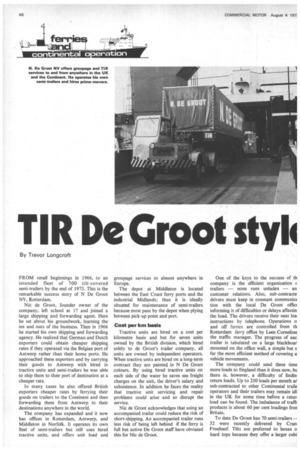TIR De Groot styli
Page 48

Page 49

If you've noticed an error in this article please click here to report it so we can fix it.
By Trevor Longcroft FROM small beginnings in 1966, to an intended fleet of 700 tilt-covered semi-trailers by the end of 1973. This is the remarkable success story of N De Groot NV, Rotterdam.
Nic de Groot, founder owner of the company, left school at 17 and joined a large shipping and forwarding agent. Here he set about his groundwork, learning the his and outs of the business. Then in 1966 he started his own shipping and forwarding agency. He realized that German and Dutch exporters could obtain cheaper shipping rates if they operated via the Belgian port of Antwerp rather than their home ports. He approached these exporters and by carrying their goods to Antwerp with hired in tractive units and semi trailers he was able to ship them to their port of destination at a cheaper rate.
In many cases he also offered British exporters cheaper rates by ferrying their goods on trailers to the Continent and then forwarding them from Antwerp to their destinations anywhere in the world.
The company has expanded and it now has offices in Rotterdam, Antwerp, and Middleton in Norfolk. It operates its own fleet of semi-trailers but still uses hired tractive units, and offers unit load and groupage services to almost anywhere in Europe.
The depot at Middleton is located between the East Coast ferry ports and the industrial Midlands; thus it is ideally situated for maintenance of semi-trailers because most pass by the depot when plying between pick-up point and port.
Cost per km basis Tractive units are hired on a cost per kilometre basis and but for seven units owned by the British division, which hired solely to de Groot's trailer company, all units are owned by independent operators. When tractive units are hired on a long-term contract they are painted. in N De Groot colours. By using hired tractive units on each side of the water he saves sea freight charges on the unit, the driver's salary and subsistence. In addition he faces the reality that tractive unit servicing and repair problems could arise and so disrupt the service.
Nic de Groot acknowledges that using an accompanied trailer could reduce the risk of short-shipping. An accompanied trailer runs less risk of being left behind if the ferry is full but active De Groot staff have obviated this for Nic de Groot. One of the keys to the success of th company is the efficient organization c trailers — none runs unladen — an customer relations. Also, sub-contracte drivers must keep in constant communica tion with the local De Groot offict informing it of difficulties or delays affectin the load. The drivers receive their next Ion instructions by telephone. Operations o and off ferries are controlled from th Rotterdam ferry office by I..een Cornelisst the traffic manager. The progress of eac trailer is tabulated on a large blackboar mounted on the office wall, a simple but s far the most efficient method of covering a vehicle movements.
The company could send three time more loads to England than it does now, be there is, however, a difficulty of findin return loads. Up to 250 loads per month ar sub-contracted to other Continental traile operators and their trailers may remain idl in the UK for some time before a retun load can be found. The imbalance of traffi products is about 60 per cent loadings fron Britain.
To date De Groot has 70 semi-trailers — 32 were recently delivered by Cram Fruehauf. Tilts are preferred to boxes o hard tops because they offer a larger cubi arrying capacity — up to 10 Cu rn. They lso offer greater loading and unloading exibility, as access to the load can be made om three sides and the top.
hawbars uneconomical Nic de Groot does not consider drawbar atflts economical for his type of operation. le would need to ferry the power unit also, id as ferry charges are assessed on the ngth of the vehicle, at 32 tons gtw, with milar payloads the artic has a length ivantage.
In the event of operating his own ferry, though this is an unlikely possibility, he ould choose to operate between Felixstowe ad Rotterdam (Europoort).
Now 90 per cent of his loads go via elixstowe, chosen because of its proximity ) his customers in the Midlands and the -equency of sailings.
Looking towards Britain's entry into the !ommon Market, Nic de Groot is ptimistic for his company. The reduction if import tariffs should increase the flow of oth imports and exports to and from dritain and he means to have his share of ie extra business. His schedules will need nly minor adjustments to cope with the hortened EEC driving day. He looks mward to the time when British drivers will e allowed to sleep in their cabs as they are n the Continent — although with naccompanied traffic this hardly seems to latter. More important, from a business oint of view, he wants to see our gross ?eights increased to match those of the :!ontinentals.








































































































